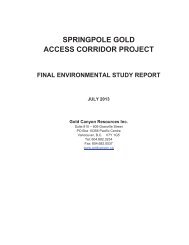Malawi NI 43-101 - December 2011 - Gold Canyon Resources Inc.
Malawi NI 43-101 - December 2011 - Gold Canyon Resources Inc.
Malawi NI 43-101 - December 2011 - Gold Canyon Resources Inc.
- No tags were found...
You also want an ePaper? Increase the reach of your titles
YUMPU automatically turns print PDFs into web optimized ePapers that Google loves.
8 DEPOSIT TYPESThe type of REE deposit being explored for in the Chambe Basin iscommonly referred to as the “ion-adsorption clay type”, although various othernames have been used including “south China type”, “Jiangxi rare earth ores” ,“weathered crust elution-deposited rare earth ores”, “MEX-REY ores”, and “ionicREE ores” . The following summary is taken from a number of sources, includingBao and Zhao (2008), Chi (1988), Chi and others (2005) , Chi and Tian (2008),Ishihara and others (2008), Kanazawa and Kamitami (2005), Maksimovic andPanto (1996), Morteani and Preinfalk (1996), Murakami and Ishihara (2008),Orris and Grauch (2002), Sanematsu and others (2009), and Wu and others(1996).Ion adsorption type REE deposits are fairly common in China, where theywere first discovered in the 1970’s, and now number at least 214 deposits (Baoand Zhao (2008)), but are almost unknown elsewhere in the world. About 90% ofthe Chinese ionic deposits are in the southern provinces, principally Jiangxi,Guang Dong, and Guang Xi, but also in Hunan and Fujian. These areas aregenerally subtropical areas south of 28˚ N with warm, humid conditions andannual rainfalls exceeding 1,500 mm. In these areas they generally develop inthe weathering zone where topography is gentle, denudation rates are low butlong-continued, and soils are consequently deep and well preserved. Mostappear to have formed by in situ weathering of granite, but some have developedby weathering of other igneous rock types (eg pyroclastics), and rarely even fromother types of rock (eg phyllite). There is also evidence from clays washed intokarst depressions in eastern Europe (Maksimovic and Panto (1996)) that REEconcentrations can develop in clays not formed in situ.Whatever the environment, REE enrichments of the ionic type appear tobe due to continuous ground water leaching that mainly decomposes accessoryREE minerals in soils, and to a lesser extent trace REE in rock- forming minerals,from the upper soils . The REE are progressively leached in upper layers andredeposited at greater depths. In China it appears the REE are mostly looselybound to clays, However, in soils developed on REE-bearing carbonatites inBrazil (Morteani and Preinfalk (1996) the REE may be mainly held in phosphates,






